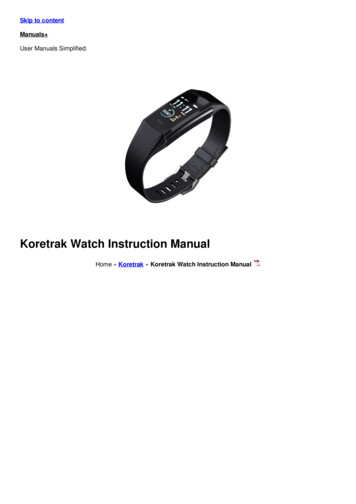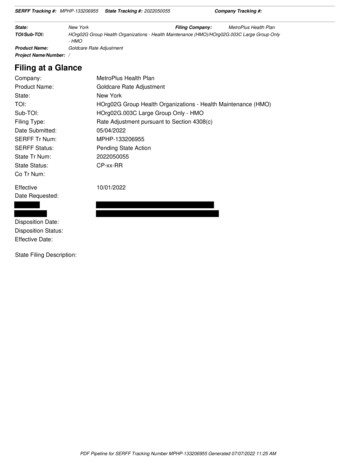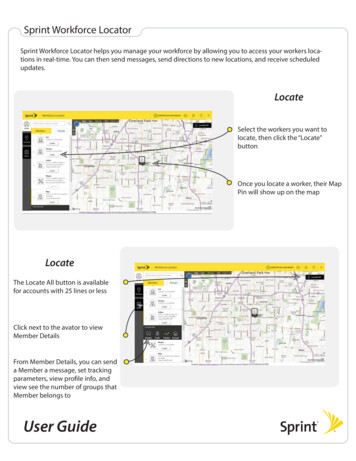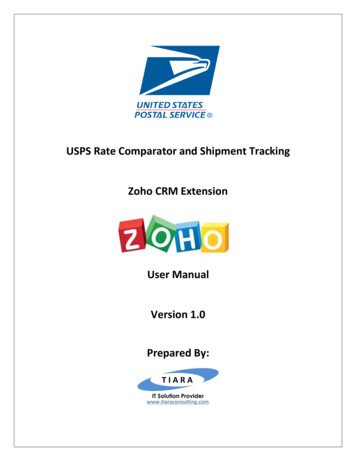Transcription
Watching You Watch: The Tracking Ecosystem of Over-the-TopTV Streaming DevicesHooman Mohajeri Moghaddam, Gunes Acar, Ben Burgess, Arunesh Mathur, Danny Yuxing Huang,Nick Feamster , Edward W. Felten, Prateek Mittal, Arvind NarayananPrinceton University and University of Chicago However, many Internet-connected TVs introduce privacy risks.These devices often have access to sensitive user data, e.g., microphone input, viewing history, and personal information. Not onlycould such data be exposed to developers who build applications(hereafter, channels) for these devices, but it could also be usedfor behavioral advertising. For example, the Federal Trade Commission (FTC) recently fined Vizio—a smart TV manufacturer—forcollecting individual users’ demographics and viewing histories fortargeting advertising without consent [60]. Moreover, for manufacturers such as Roku, advertising has surpassed device sales as theprimary source of income [38, 52, 56, 73]. In fact, we have foundevidence of trackers collecting user identifying information andviewing behavior in Roku’s network traffic, as shown in Figure 1.In this paper, we examine the advertising and tracking ecosystemof Over-the-Top (“OTT”) streaming devices, which deliver Internetbased video content to traditional TVs/display devices. OTT devicesrefer to a family of services and devices that either directly connectto a TV (e.g., streaming sticks and boxes) or enable functionalitywithin a TV (e.g., smart TVs) to facilitate the delivery of Internetbased video content [25].Specifically, we are interested in identifying endpoints that OTTchannels contact to serve advertisements and/or track users; theentities that these endpoints are associated with; what informationOTT channels send to them; and how they potentially track users.To this end, we build an automated system that collects channelinformation from OTT channel stores, loads individual channelson an OTT device, and attempts to play a video clip and trigger avideo ad while capturing network traffic. In particular, we studytwo of the most popular OTT streaming devices in the market:the Roku Channel Store [67] and the Amazon Fire TV channelstore [3]. We examine the network traffic of 1,000 channels fromthe Roku Channel Store and 1,000 channels from the Amazon FireTV channel store. Automated analysis of these channels at scalepresents two key challenges that previous studies examining thirdparty tracking at scale on the web [23] and mobile devices [59]have not encountered:Challenge 1: Automated Interaction: Unlike web browsersand mobile devices, where visiting, launching and interacting withapplications is enabled by existing automation software (e.g., Selenium [71]), to the best of our knowledge there is no such solutionfor OTT devices. Even though many OTT devices have a remotecontrol API, the interaction is virtually limited to sending commands and coarse-grained feedback, such as the current channelviewed. The lack of fine-grained feedback, such as what text isshown on the TV screen or whether a video clip or video advertisement (ad) is being played on the TV, makes it difficult to executethe complex interaction required to play videos on channels. Tomitigate this lack of feedback, we build a system that uses audioABSTRACTThe number of Internet-connected TV devices has grown significantly in recent years, especially Over-the-Top (“OTT”) streamingdevices, such as Roku TV and Amazon Fire TV. OTT devices offeran alternative to multi-channel television subscription services,and are often monetized through behavioral advertising. To shedlight on the privacy practices of such platforms, we developed asystem that can automatically download OTT apps (also known aschannels), and interact with them while intercepting the networktraffic and performing best-effort TLS interception. We used thissmart crawler to visit more than 2,000 channels on two popularOTT platforms, namely Roku and Amazon Fire TV. Our resultsshow that tracking is pervasive on both OTT platforms, with trafficto known trackers present on 69% of Roku channels and 89% ofAmazon Fire TV channels. We also discover widespread practice ofcollecting and transmitting unique identifiers, such as device IDs,serial numbers, WiFi MAC addresses and SSIDs, at times over unencrypted connections. Finally, we show that the countermeasuresavailable on these devices, such as limiting ad tracking options andadblocking, are practically ineffective. Based on our findings, wemake recommendations for researchers, regulators, policy makers,and platform/app developers.CCS CONCEPTS Security and privacy Privacy protections.KEYWORDSprivacy; OTT; third-party tracking; measurement; Internet TV;automation1INTRODUCTIONThe number of Internet connected TV users has increased steadilyover the past few years and an estimated 65.3% of Internet usersin the United States (US)—close to 182.6 million people—used anInternet connected TV device in 2018 [20]. In fact, “cord-cutting”patter, where users replace their traditional cable TV subscriptionwith content delivered through Internet connected TV platformsto avoid long-term multi-channel subscription commitments, hasbeen a very popular trend in recent years [77].Permission to make digital or hard copies of part or all of this work for personal orclassroom use is granted without fee provided that copies are not made or distributedfor profit or commercial advantage and that copies bear this notice and the full citationon the first page. Copyrights for third-party components of this work must be honored.For all other uses, contact the owner/author(s).CCS ’19, November 11–15, 2019, London, United Kingdom 2019 Copyright held by the owner/author(s).ACM ISBN 19535.33541981
HTTP outbound to 192.35.249.124:80(DNS: search.spotxchange.com)(channel name: asiancrush)GET./vast/3.0/146141?VPI[] MP4&VPI[] ROKU&app[name] asiancrush&app[domain] asiancrush.com&app[bundle] com.dmr.asiancrush&player width 1280&player height 720&device[devicetype] 7&device[make] Roku&device[model] Roku&device[ifa] 39fc6352-aede-53f6-b3e3-58bf562bd074&ip addr 128.112.139.195&cb 1557313464653&custom[movie title] So%20Young%202%3A%20Never%20Gone&custom[content id] 3417&token[device id] ion] wifi&token[category ID] 241&token[category Title] Romance&device[dnt] 0&max bitrate 7000 HTTP/1.1Host: search.spotxchange.comUser-Agent: Roku/DVP-9.0 (519.00E04142A)Accept: */*Figure 1: AsianCrush channel on Roku sends device ID and video title to online video advertising platform spotxchange.com.and pixel content to infer the state of video playback on the TV, aswe will explain in detail in Section 3.Challenge 2: Intercepting Traffic: Unlike web browsers andmobile devices which expose capabilities to install root certificatesto intercept HTTPS traffic, OTT streaming devices are largely closedand proprietary, making it harder to intercept and analyze encrypted traffic. To this end, we modify mitmproxy to interceptand decrypt HTTPS traffic via best-effort. Where possible, we deploy our own TLS certificate to the device and use external toolkits(e.g., Frida [29] for the Amazon Fire Stick TV) to bypass certificatepinning.Contributions: We make the following contributions: We conduct the first large-scale study of privacy practicesof OTT streaming channels. Using an automated crawlerthat we developed in house, we crawled more than 2,000channels and found widespread practices of tracking. We build the first system that can automate the interactionof OTT channels and the interception of network activities.We will open-source the system, which can be used by otherresearchers to study similar OTT and smart TV platforms. We discover collection of persistent identifiers (such as WiFiMAC addresses and SSIDs) for tracking, at times over unencrypted connections. We find connection to at least onetracker on the traffic of 691 of the most popular 1,000 channels on Roku and 894 of the most popular channels on Amazon Fire TV. Analyzing the local remote control APIs of the OTT devices,we find a vulnerability that allows a malicious web script toextract a Roku user’s location, retrieve installed channels, install new channels and access device identifiers. We reportedthe vulnerability to the vendor, who has rolled out a fix.22.1.1 Web Tracking: Techniques and Measurement. Some of the earliest studies of online tracking began examining the presence andpractices of third-party entities embedded on websites [36, 42, 63],finding pervasive use of third-party cookies to track users acrosswebsites. Successive studies discovered novel third-party trackingtechniques that are difficult to counter. For example, studies haveshown how users can be tracked on the Web using Flash cookies [74], browser fingerprinting [18], canvas fingerprinting [45],performance characteristics [44], font metrics [27] and installedbrowser extensions [31, 76].While these studies illuminated several types of tracking mechanisms, only recently have researchers begun measuring and examining their behavior at scale. For example, Nikiforakis, et al.measured the prevalence of third-party JavaScript on the AlexaTop 10,000 websites, and identified new ways an adversary couldcompromise websites such as by registering stale domains thatvictim websites load scripts from [51]. In another instance, Libertused an instrumented headless browser to study third-party tracking and discovered that websites that leak user data contact anaverage of nine different third parties [39]. Finally, Acar et al. builtFPDetective [2] to measure the prevalence of various fingerprintingtechniques on the web over the Alexa Top 1 Million websites.More recently, Englehardt and Narayanan designed and builtOpenWPM—an instrumented web crawler based on Selenium—and used it to measure the prevalence of various kinds of browserfingerprinting on the Alexa Top 1 Million pages [23], discoveringthat a few large third parties are responsible for most tracking on theweb. Other studies using OpenWPM have shown how web trackingexposes users to network surveillance by sending identifiers inthe clear [24], and how nearly 30% of all emails leak users’ emailaddresses to third parties [22]. More recently, Das et al. [10] foundthat several third parties in the Top 100K Alexa websites use sensorAPIs—such as motion, orientation proximity and light—available inmobile browsers for tracking and analytics.RELATED WORK AND BACKGROUNDIn this section we review the related work, and we describe theOTT streaming devices we studied in our work.2.12.1.2 Mobile Tracking. Numerous studies have documented thethird-party entity landscape of mobile applications. Privacy implications of mobile apps have been extensively studied in theliterature [21, 32, 61]. Xia et al. showed that up to 50% of the smartphone traffic can be attributed to users’ real names [82]. Reyes etal. analyzed 5,855 popular free children’s apps and found widespread violation of the Children’s Online Privacy Protection Act(“COPPA") [62]. Other work explored ways to track users on mobileRelated WorkNumerous studies have examined different aspects of online tracking, ranging from understanding how tracking works, what entitiesengage in tracking, and the implications of tracking for consumerprivacy. In this section, we summarize the related literature andplace our study in context.2
platforms by fingerprinting smartphone configurations [37], acoustic components [11], sensors [12, 13, 48], battery readings [54], andambient light level [53]. Ren et al. presented ReCon [61], whichdetects potential PII leaks by inspecting network traffic and allowsusers to control dissemination. They ran a study with 92 participants to measure PII exposure on the 100 most popular iOS, Android,and Windows Phone apps.our crawler was built to be largely agnostic to the underlying devicetype. In future work, researchers can replace a small portion of ourRoku- and Amazon-specific code with APIs of other OTT platforms.2.1.3 Privacy and Security of Smart Devices. Analyzing 20 IoT devices, Loi et al. proposed a systematic method to identify the securityand privacy issues of various IoT devices including home security,energy management and entertainment devices [40]. Fernandes etal. studied security of 499 SmartThings apps and 132 device handlerson Samsung’s SmartThings platform and found security flaws in theframework [26]. Wood et al. studied four medical devices and foundthat one device occasionally sends sensitive health data in cleartext [81]. Acar et al. used DNS Rebinding [14] to gather sensitiveinformation and control IoT devices with local HTTP interfaces [1].Finally, Malkin et al. [41] surveyed current and prospective smartTV users regarding their privacy understanding and expectationswith regards to these platforms and concluded that there is verylittle transparency and understanding of privacy practices on theseplatforms.In this section, we describe our data collection pipeline: the listof channels we crawled, and our crawler infrastructure. We alsodiscuss different settings and preferences we used for all the crawlswe performed in our study.2.233.1SMART CRAWLER AND DATACOLLECTIONCompiling Channel ListsWe compiled a list of channels from the Roku and Amazon Fire TVchannel stores. We compiled these lists in May 2019.3.1.1 Roku Channel Lists. Roku channels are organized by category on the Roku Channel Store website, with each channel belonging to only one category. To compile a list of channels, we extractedall the channels within each category. Each category page on thewebsite (e.g., s a list of channels in that category along with each channel’s metadata information—its ID, description, Roku’s internalchannel popularity ranking, and the identity of its developer—all ofwhich we recorded. This resulted in a list of 8,660 channels across23 categories.To keep our crawls tractable while analyzing channels that usersare more likely to encounter, we did not extract all the 8,660 channels. Instead, we created a new list, sorting the list of 8,660 channelsby rank and retaining the top 1,000 channels (Roku-Top1K). Inaddition, to test various features of the OTT devices (e.g., privacycontrols), we created a list of 100 channels (Roku-CategoriesTop100) by selecting the top 10 channels by rank from the following categories: “Movies & TV”, “Kids & Family”, “Sports” , “Fitness”,“Religious”, “Food”, “Shopping”, “Educational”, “Special Interest”,and “News & Weather”. We chose these categories since they contained the most channels overall.Platforms and Channel StoresWe examined the advertising and tracking ecosystem of servicespresent on two of the most popular OTT streaming device families:Roku and Amazon Fire TV. We specifically chose these two, sincetogether they account for 59% to 65% of the market share globally [8,19, 20]. Both device families consist of various external devices thatusers connect to displays (such as TVs) via HDMI. These devicesstream video content over the Internet through channels (like apps).Users can download and install channels on their devices from theRoku Channel Store [67] and the Amazon Fire TV channel store [3].Roku streaming devices run a proprietary operating system developed by Roku, Inc. The Roku channels are packaged, signed andencrypted to ensure confidentiality of the source code. Only Rokudevices have the ability to decrypt the channels. As a privacy option, Roku allows users to “Limit Ad Tracking” to disable identifiersused for targeted advertising and Roku’s developers documentationstates that channels should not use the data collected from thedevice to serve personalized advertisements when this option isenabled [64].Amazon Fire TV devices run a custom version of the Androidoperating system. Amazon Fire TV channels are packaged in theAndroid Application Package (APK) format, and—as with most Android devices—developers can interact with the Fire TV devices using the Android Debug Bridge (adb) tool1 . Similar to Roku, Amazonallows users to “Disable Interest-based Ads” and limit behavioralprofiling and targeting [4].We performed our crawls on both Roku and Amazon Fire TVfamily of devices, more specifically using Roku Express [69] and theAmazon Fire TV Stick [5] since these are the most popular and leastexpensive options within each family. Note that while we crawledthe channels from the channel stores using these specific devices,3.1.2 Amazon Fire TV Channel Lists. Like Roku, Amazon Fire TVchannels are organized as a list on the Amazon Fire TV channelstore website, with some channels belonging to multiple categories.We recorded all the channels from this list, including each channel’smetadata—its ID, description, Amazon Fire TV’s internal channelpopularity ranking, and the identity of its developer—resulting in alist of 6,782 channels across 29 categories.As with the Roku channel lists, we retained the top 1,000 channelsby rank (FireTV-Top1K) for crawling. In addition, we also createda list of 100 channels (FireTV-CategoriesTop100) by selecting thetop 10 channels by rank from the following categories: “News &Weather”, “Movies & TV”, “Sports”, “Lifestyle”, “Health & Fitness”,“Food & Drink”, “Kids”, “Shopping”, and “Education”. We chose thesecategories since they contained the most channels overall. Becausesome of these channels belonged to multiple categories, this listcontained 86 channels in total.1 adb3
Audio outputFor successive crawls, we installed the channels from the APK filesusing adb as opposed to the channel store. The crawler then usesadb commands to install the channel APK files, which we retrievefrom the Amazon Fire TV channel store ahead of running anycrawls.EthernetInternetStoreWiFi AccessPointVideooutputCrawlerCommandsDesktop MachineVou idetp outTV DisplayVideooutputHDMI Captureand Split Card Packet Capture DNS Capture Screenshots Audio recordings3.2.2 Triggering Video Playback. While merely launching a channel might reveal initial insight into its advertising and trackingecosystem, triggering video playback and watching content, likean actual user, provides a more thorough and complete view. Whileour crawler can interact with channels using the OTT device’sremote control APIs, triggering video playback in an automatedfashion is challenging because channels’ user interfaces vary widely.Therefore, we developed our crawler to maximize the probabilityof triggering video playback in channels.To maximize the probability, we first analyzed how a humanwould interact with a channel to play a video. We randomly selected 100 channels from the Roku-Top1K list. For each channel, wemanually recorded the shortest sequence of keystrokes that leadsto video playback (e.g., the “Down” button followed by the “OK”button). The three sequences that triggered video playback on themost channels were: [OK, OK, OK], [Down, OK, OK] and [OK, OK,Down, OK, Down, OK].The crawler employs these three key sequences by first openinga channel, executing one key sequence, and then checking theaudio output signal (as a proxy for video playback). The crawlerdetects the audio signal by comparing the amplitude of the last fiveseconds of audio to the noise, and then checking if the differencebetween the two is greater than a certain threshold; we determinedthis threshold through iterative testing. If the crawler does notdetect an audio signal, it assumes the key sequence did not work,restarts the channel, and then proceeds to play the remaining keysequences.We tested the efficacy of our audio detection method by manually labelling screenshots from a sample of 150 channels withwhether or not they achieved video playback. We compared this“ground truth” to the crawler’s audio detection log to determinethe accuracy, noting false positives and false negatives. Overall,the audio detection method was accurate in 144 of the 150 (96%)channels. We discovered only six cases of false positives (out of 40detections) where the crawler erroneously concluded video playback had taken place. These were due to menu animations, audioguides and background music. We found no false negatives.OTT Device(e.g., Roku)Figure 2: Overview of our smart crawler.3.2Smart Crawler Infrastructure3.2.1 Overview and Setup. Figure 2 illustrates our smart crawlersetup. Our crawler consists of four physical devices: a desktop machine, a TV display, an HDMI split and capture card, and the OTTdevice. The desktop machine executes the crawler code, orchestrates the crawl and stores the resulting data.The desktop machine acts as a WiFi access point (AP) and itswireless network interface is bridged to the Internet. The OTTdevice connects to this AP, which allows us to capture the OTTdevice’s network traffic. The OTT device outputs its video to botha TV display and a desktop machine by means of an HDMI capturecard. The TV display allows us to visually inspect the crawler’s behavior and we use the screenshot captures on the desktop machineto validate our findings visually and for further debugging. Finally,the TV display’s audio output connects to the desktop machine’saudio input, which we capture into files using arecord. Thus, thedesktop machine—and thus the crawler—receives both audio andvideo signals emitted from the OTT device.The crawler interacts with the OTT devices using their remotecontrol APIs. Roku and Amazon Fire TV expose their remote controlfunctionality via web APIs and adb respectively, both of which canreceive keystroke commands to interact with the device. For example, “adb shell input keyevent 21” sends the “left” key to Amazon Fire TV devices, and an HTTP GET request to “http://ROKUDEVICE IP ADDRESS:8060/keydown/left ” does the same for allRoku devices.The crawler uses a combination of such device commands tolaunch and install channels starting from the home screen of eachOTT device. Operating one channel at a time from the list of channels, the crawl installs a channel, launches it, and interacts with it toplay video. Soon after launching the channel, the crawler capturesand attempts to decrypt various network and application level data.Finally, the crawler uninstalls the channel to free space on the OTTdevice.The crawler’s channel installation process is platform specific.On Roku, the crawler starts from the home page; visits the RokuChannel Store; opens the channel’s page using its channel ID; andpresses “Install” to install the channel. On Amazon, we discoveredthat delays in having channels appear on the device from the Amazon Fire TV channel store made the crawl prohibitively long andunrepeatable. Therefore, while compiling the list of channels tocrawl, we installed each channel, waited for it to appear on thedevice, and then extracted the APK files from the device using adb.3.2.3 Collecting Network Data and Intercepting Encrypted Communications. The crawler collects the entire network level data as aPCAP file from the time of launching each channel to the time it isuninstalled. For each channel, the PCAP dump contains information about all DNS queries, HTTP requests, and TLS connectionsmade during the crawl. The crawler also keeps track of all DNSqueries in a Redis2 key-value database for immediate retrieval andfurther analysis. The crawler attempts to decrypt TLS traffic withmitmproxy which we will describe next.2 https://redis.io4
(a)(b)(c)(d)(e)Figure 3: A run of our smart crawler on a channel on Roku. The smart crawler launches the channel from the home screen(a); navigates to a video on the channel menu (b); waits for the video to start playing (c); plays and forwards the video (d); andencounters an advertisement (e).Decrypting TLS Traffic with mitmproxy: An open-source toolfor intercepting and decrypting TLS traffic, mitmproxy [43], replaces the server’s certificate with a different certificate transparently. If the channel does not properly validate the certificate, wecan successfully intercept the TLS session and decrypt the capturedtraffic using the private key associated with the injected certificate. In practice, however, implementing this technique for OTTsinvolves multiple challenges. An OTT channel may establish TLSconnections using a number of TLS implementations and settings,some of which may reject the certificate used for interception andthe channel may fail to load at all. To overcome this, we wrote aTLS intercept companion script for mitmproxy. After a channelcontacts a new TLS endpoint, the script learns whether or not theconnection can be intercepted for that channel by examining theTLS alerts, and then adds the endpoints to the “no-intercept list” ifTLS interception fails. However, TLS failures caused during thislearning phase regularly interfere with the loading of a channel.In order to avoid such failures, we perform a warm-up stage inwhich we launch each channel multiple times beforehand to learnun-interceptable endpoints.We also perform a number of optimizations to minimize thechance of TLS interception interfering with channel loading andperformance. First, since the validation of the server’s TLS certificate is performed on the client side, we assume all domains mappedto the same IP address behave similarly with respect to TLS interception. Therefore, our TLS intercept script uses the DNS capturedaemon to obtain all other IP addresses mapped to the same domainand add them to the “no-intercept list”. Second, we use the PublicSuffix List [28] to extract base domains from hostnames, and wetreat a base domain and its subdomains in the same way. Third, thescript signals to the crawler when we learn no new un-interceptableendpoint during a warm-up launch, so the crawler can finish thewarm-up phase earlier to save time. See Appendix A for more information on how we chose our warm-up parameters such as thenumber of warm-up crawls. Finally, for each channel, the crawlerdumps all the TLS session keys for each intercepted session into afile, which can be used by Wireshark/tshark3 to decrypt sessions.We then generate a list of all successfully intercepted endpoints.Certificate Injection and Pinning: On Roku, our TLS interception rate is bounded by the number of channels with incorrectvalidation of certificates, since we cannot deploy our own certificateto the device. We compared the success rate of TLS interception using different X.509 certificates (see Appendix A for details) and useda self-signed certificate generated by mitmproxy with a commonname matching the original certificate’s common name.On the Amazon Fire TV, however, we gained access to the system certificate store by rooting the device and installed our owncertificate [70]. This allowed us to intercept more TLS endpointsbeyond the ones that had a faulty certificate validation implementation. However, many channels and system services use certificatepinning [55]. We built a script which uses the Frida toolkit [29]to bypass channel level certificate pinning for all of the runningchannels, which we discuss in detail in Appendix B.3.3List of CrawlsNext, we summarize the list of crawls we conducted, and we describe the configurations for each crawl. As shown in Table 1, weconducted five different crawls on each platform.3.3.1 Smart Crawls. In the following crawls, we used the smartcrawler to interact with and trigger video playback on channelscompiled using the method described in Section 3.1: Top1K Crawls: We crawled the top 1,000 channels—RokuTop1K and FireTV-Top1K—on both the Roku and AmazonFire TV channel stores with two configurations. In the firstconfiguration, we intercepted encrypted traffic on both Rokuand the Amazon Fire TV channels using the techniques3 ml5
Crawl DataPrcoessed DataRaw nNamesDataAnalysisTrackerDatabasesFigure 4: Data processing pipelinewe described in Section 3.2.3. We call these crawls RokuTop1K-MITM and FireTV-Top1K-MITM respectively. Asa point of comparison, we crawled the same channels without intercepting any encrypted traffic to analyze the success of our interception. We call these crawls Roku-Top1KNoMITM and FireTV-Top1K-NoMITM. Privacy Settings Crawls: Next, we examined the efficacy ofthe privacy settings provided by Roku and the Amazon FireTV. To do so, we first crawled the top 100 channels—RokuCategoriesTop100 and FireTV-CategoriesTop100—picked acrossten different categories from the Roku and Amazon FireTV channel stores, intercepting encrypted traffic as before.We call these crawls Roku-CategoriesTop100-MITM andFireTV-CategoriesTop100-MITM respectively. We thenrepeated the same crawls, this time enabling the “Limit AdTracking” (Roku) and the “Disable Interest-based Ads” (Amazon Fire TV) settings. We call these crawls Roku-CategoriesTop100-LimitAdTracking and FireTV-CategoriesTop100DisableInterestAds respectively.4.2Data ProcessingAfter gathering the raw data for each crawl, we performed a processing step to extract relevant information. For instance, since weselectively attempted to intercept TLS connections, we needed away to detect connections that we attempted to intercept. To do thiswe looked for certificates issued by mitmproxy using the following tshark filter: x509sat.uTF8String mitmproxy. We labeledTLS connections as successfully intercepted if there was at least oneTLS record containing payload (i.e. with ssl.record.content type equal to 23) that was sent from the OTT device. We labeledthe remaining TLS connections, which were attempted but had nopayload originating from the OTT device, as interception failures.We also used TCP connections throughout the paper for various measurements, since they contain both encrypted and unencrypted connections. For certain analyses, including measuringtracker prevalence, we needed a way to determine the hostnamethat c
In this paper, we examine the advertising and tracking ecosystem of Over-the-Top ("OTT") streaming devices, which deliver Internet-based video content to traditional TVs/display devices. OTT devices refer to a family of services and devices that either directly connect to a TV (e.g., streaming sticks and boxes) or enable functionality










